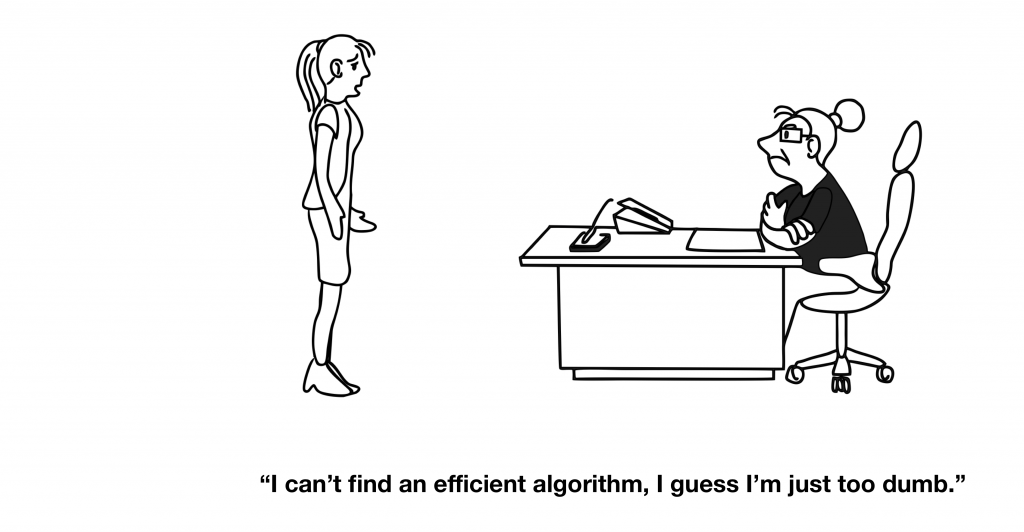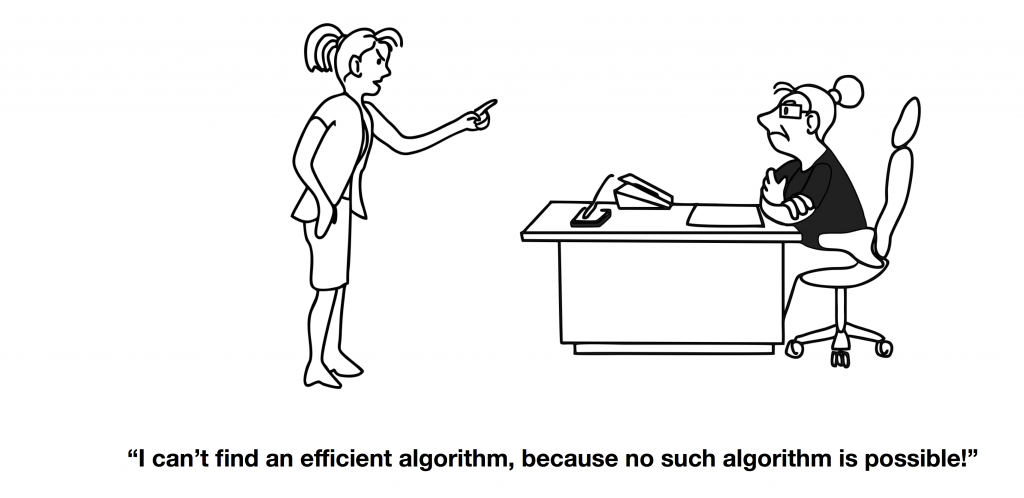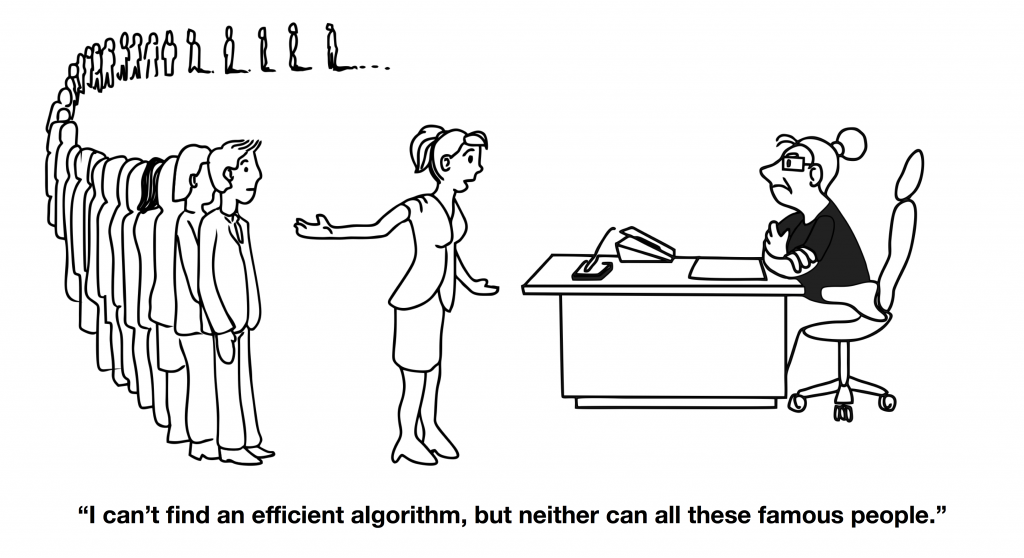COMP3010: Algorithm Theory and Design
Daniel Sutantyo, Department of Computing, Macquarie University
1.1 Problems and Algorithms
Topics
1.1 - Problems and Algorithms
- Problems
- Algorithms
- Why study algorithms
Algorithm
1.1 - Problems and Algorithms
- Definition:
- a procedure to accomplish a specific task
- Wikipedia: finite sequence of well-defined, computer-implementable instructions, typically to solve a class of problems or to perform a computation
- CLRS: well-defined computational procedure that takes some value as input and produces some value as output
- Exact definitions are not that important, it's more important that you understand the concepts
Algorithm
1.1 - Problems and Algorithms
- Algorithm is used to solve problems (or specifically, computational problem)
- What is a computational problem?
- Given a set of inputs and a set of outputs, a computational problem specifies the desired relationship between the two sets
- Example:
- Given an array \(A\), find the largest value in \(A\)
- Given an integer \(n\), find the nontrivial prime factors of \(n\)
- Given a map with \(n\) cities and the cost of travelling between each pair of cities, find the cheapest way to travel from A to B
Computational Problem
1.1 - Problems and Algorithms
- Why even talk about what a problem is? We are in 3rd year!
- a different point of view (maybe?)
- Problem: Given an array \(A\), find the largest value in \(A\)
[ 5, 1, 7, 2, 6, 9, 11 ]
11
Computational Problem
1.1 - Problems and Algorithms
[ 11, 9, 7, 6, 5, 2, 1 ]
[ 1, 2, 5, 6, 7, 9, 11 ]
[ ]
[ 1, 1, 1, 1, 1, 1 ]
[ 5.6, 4.1, 2.7, 2.1, 16.0, 9.1]
[ 5, 1, 7, 2, 6, 9, 11 ]
11
["chicken","beef","lamb"]
[null,null,null,null]
Computational Problem
1.1 - Problems and Algorithms
- A computational problem should have a well-defined input, including any constraints, plus a well-defined output and how it relates to the input
- bad: Given an array \(A\), find the largest value in \(A\)
-
better:
- Given an array of integers \(A\), find the largest value in \(A\)
- input: an array of integers
- output: the largest integer in \(A\)
- The first step in solving a problem is to understand the problem, and this requires you to understand what the inputs are and how the output is related
- Don't start solving a problem until you understand it
Computational Problem
1.1 - Problems and Algorithms
- Given a positive integer \(n\), find the nontrivial prime factors of \(n\)
- input: a positive integer \(n\)
- output: the nontrivial prime factors of \(n\)
Computational Problem
1.1 - Problems and Algorithms
- Given a map with \(n\) cities and the cost of travelling between each pair of cities, find the cheapest way of travelling between city A and city B
- input:
- a map with \(n\) cities
- the cost of travelling between any two cities
- the cities A and B
- output:
- the cheapest way of travelling between city A and city B
- input:
Computational Problem
1.1 - Problems and Algorithms
- So when given a problem, you should think about
- the set of inputs (what kind of inputs you are getting)
- the set of outputs (what kind of output you need)
- how do you link them
Not Computational Problem
1.1 - Problems and Algorithms
- These are not computational problems:
- Find the best place in Australia
- input and output: ??? what is a place? a city? a beach? a bar?
- what does 'best' mean?
- Given a set of triangles, sort them
- input: set of triangles
- output: the same set of triangles in different order
- problem: how do you sort them?
- Find the best place in Australia
Computational Problem
1.1 - Problems and Algorithms
2
3
...
15
16
...
[2]
[3]
...
[3,5]
...
input
output
- Given a positive integer \(n\), find the nontrivial prime factors of \(n\)
- input: a positive integer \(n\)
- output: the nontrivial prime factors of \(n\)
Computational Problem
1.1 - Problems and Algorithms
[ 5, 1, 7, 2, 6, 9, 11 ]
11
[ 1, 2, 5, 6, 7, 9, 11 ]
[ 11, 9, 7, 6, 5, 2, 1 ]
[ 1, 1, 1, 1, 1, 1, 11 ]
. . .
[ 1 ]
1
. . .
[ 1, 1 ]
[ 1, 1, 1]
- Given an array of integers \(A\), find the largest value in \(A\)
- input: an array of integers
- output: the largest integer in \(A\)
[ ]
???
Computational Problem
1.1 - Problems and Algorithms
- The hope is that you can now see a problem as a set of inputs and outputs and the desired relationship between them
- A particular input to a problem is referred to as an instance of a problem
Wikipedia: a computational problem can be viewed as an infinite collection of instances together with a possibly empty, set of solutions for every instance
- An algorithm gives you that relationship, i.e it maps the inputs to the correct output
- An algorithm is correct if for every instance it halts with the correct output
Computational Problem
1.1 - Problems and Algorithms
- I like thinking about the input first because it gives me some idea about the complexity of the problem (how many possible inputs are there)
- It can also help me optimise my solution
- can I ignore certain type of inputs?
- will I get small inputs or large inputs?
- Obviously the type of input also tells me what data structure I can use
- See Chapter 10 of Skiena (it's only 3-4 pages)
Types of Computational Problem
1.1 - Problems and Algorithms
-
Decision problem: the output to every instance of input is either a yes or a no
- Given a positive integer \(n\), is it a prime number?
- Given a map with \(n\) cities and the cost of travelling between each city, can you travel from city A to city B for less than \(x\)?
-
Search problem: find one or more output that satisfies the required relation to the input
- Given a positive integer \(n\), find its nontrivial prime factors
- Given a map with \(n\) cities and the cost of travelling between each pair of cities, find all possible paths between city A and city B
Types of Computational Problem
1.1 - Problems and Algorithms
-
Counting problem: find the number of solutions to a given search problem
- Given a positive integer \(n\), how many nontrivial prime factors does it have?
- Given a map with \(n\) cities and the cost of travelling between each pair of cities, find the number of possible paths between City A and City B
-
Optimisation problem: find the best possible solution among the set of all possible solutions to a search problem
- Given a map with \(n\) cities and the cost of travelling between each pair of cities, find the cheapest cost of travelling between City A and City B
Why Study Algorithms?
1.1 - Problems and Algorithms
- Obvious solutions are not always tractable
- tractable: can be solved in polynomial time, i.e. 'easy'
- Tractable solutions can be improved
- Recognise hard problems
- prevents us from wasting time looking for an efficient solution
Obvious solutions are not always tractable
1.1 - Problems and Algorithms
- Brute-force solution:
- Compute every single possible paths
- What is the number of possible paths from A to B?
no intermediate cities
1 intermediate city
\((n-2)\) choices
\(\vdots\)
A
A
B
B
\(\vdots\)
A
B
2 intermediate cities
\((n-2)(n-3)\) choices
1 choice
Obvious solutions are not always tractable
1.1 - Problems and Algorithms
$$ 1 + (n-2) + (n-3)(n-2) + (n-4)(n-3)(n-2) + \cdots + \binom{n-2}{k}k! $$
- Total number of paths:
(via 1 city)
(via 2 cities)
(via 3 cities)
(via \(k\) cities)
- For large \(n\), it is impossible to check all paths, e.g. \(50!\approx 3.04 \times 10^{64}\)
50! = 30,414,093,201,713,378,043,612,608,166,064,768,844,377,641,568,960,512,000,000,000,000
Tractable solutions can be improved
1.1 - Problems and Algorithms
- Given a list of \(n\) integers, find the largest and smallest integers among them
- What is the minimum number of comparisons that you need to do?
- \((n-1)\) comparisons, why?
- How many comparisons do you need to find the largest and the smallest integers?
Tractable solutions can be improved
1.1 - Problems and Algorithms
- Given a list of \(n\) integers, find the largest and smallest integers among them
- Our first solution is likely to be \((2n-2)\) comparisons, i.e. just go through each numbers and record the maximum and minimum so far
13
63
44
22
93
21
72
67
- We need \((2 * 8 - 2)\) = 14 comparisons in the above example
- Our first solution is likely to be \((2n-2)\) comparisons, i.e. just go through each numbers and record the maximum and minimum so far
Tractable solutions can be improved
1.1 - Problems and Algorithms
- Given a list of \(n\) integers, find the largest and smallest integers among them
- Another method: (assume \(n\) is even) pair up the numbers by doing \(n/2\) comparisons
13
63
44
22
93
21
72
67
44
13
22
72
21
63
93
67
4 comparisons
3 comparisons
3 comparisons
- In total, the number of comparisons you need is roughly: $$\frac{n}{2} + \left(\frac{n}{2}-1\right) + \left(\frac{n}{2}-1\right) = \left(\frac{3n}{2} - 2\right)$$
Recognise hard problems
1.1 - Problems and Algorithms
- In later weeks you are going to learn about intractable problems, that is, problems that have no known polynomial (i.e efficient) solution
- If you have to solve a problem, and you can see that it is intractable, then you should not waste time trying to find an efficient solution for it!
Recognise hard problems
1.1 - Problems and Algorithms

Cartoon by Stefan Szeider, available at https://www.ac.tuwien.ac.at/people/szeider/cartoon/
Recognise hard problems
1.1 - Problems and Algorithms
Cartoon by Stefan Szeider, available at https://www.ac.tuwien.ac.at/people/szeider/cartoon/

Recognise hard problems
1.1 - Problems and Algorithms
Cartoon by Stefan Szeider, available at https://www.ac.tuwien.ac.at/people/szeider/cartoon/

How do you study algorithms?
1.1 - Problems and Algorithms
- We start by going through the theoretical foundations
- so far we have defined a few terms which we will need for later parts (problems, intractability)
- later we will learn more tools (asymptotic notations, loop invariants)
- We go through the most common problem solving strategies (divide-and-conquer, dynamic programming)
- You learn by examples, and most importantly, by writing your own solutions
How do you study algorithms?
1.1 - Problems and Algorithms
- What makes a good chef?
- do you copy (or adapt) other people recipes?
- do you memorise recipes?
- do you only study recipes?
- do you study the ingredients?
- do you study your utensils?
- can you be a good chef if you only read and memorise recipes?
- can you be a good chef if you don't cook?
COMP3010 - 1.1 - Problems and Algorithms
By Daniel Sutantyo
COMP3010 - 1.1 - Problems and Algorithms
Introduction to the unit
- 261



